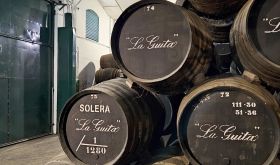Ted Bennett and Deborah Cahn of Navarro have been making pure,
fruity reds and aromatic whites in the cool, foggy Anderson Valley for 30 years now, without hype or major policy shift. They have since been joined most notably by Roederer who, alone among the Champenois who invaded California in the late 1980s, decided Anderson Valley rather than Carneros could deliver the subtlety they craved. Their daughter is now in the graduate viticulture and enology program at UC Davis but they have been extremely laid back about marketing their wines so the easiest way to buy them is from their own atmospheric website www.navarrowine.com where this wine is on offer for a mere $21 a bottle – a refreshing change from so
many California wine prices.
For the wine techies among you, here's what Ted Bennett wrote
to me recently about how this wine is made:
Méthode à l'Ancienne is a fancy way to say the “old fashioned way” and it refers to the fact that we gently punch down the cap of our fermenting Pinot Noir rather than pumping- over. It is a labor intensive way to make Pinot but it helps minimize harsh tannins and enhances the bright fruit.
The grapes are harvested in the early morning; typically between 45 and 50 degrees F. The grapes are de-stemmed, then placed in either a ¾ ton macro-bin or a 5 ton open-top SS fermentor to soak. No SO2 is added at the crusher, no yeast is added to the must and we try to keep the grapes cold for several days. Both types of fermentors are punched down daily and on the third or fourth day, when the must is starting to de-gas (something is fermenting!), we add a half-dose of a commercial S.C. yeast to assure the fermentation finishes. Once fermenting, the must is punched down three times a day until we reach 12 degrees alcohol. Typically this is 8 to 12 days after harvest and at that point, the must is pressed; the first squeeze along with the free run is racked to a tank for malolactic inoculation and settling of the gross lees. (Heavier press fractions are not used in our varietal bottlings. We press at 12% alcohol to avoid seed tannins which are selectively extracted by alcohol; we prefer to extract from the skins by natural enzymatic reaction by our pre-fermentation cold soak.) On the third or fourth day, the wine is racked off the gross lees and into barrels to complete malolactic fermentation.
Suffice it to say that this wine is pure pleasure at a very reasonable price. And what more could one ask for? Look out for it on wine lists of American restaurants with particularly astute sommeliers.













